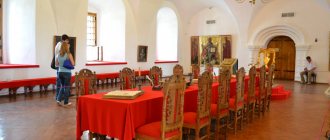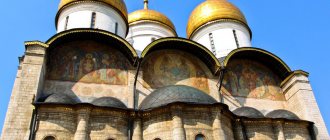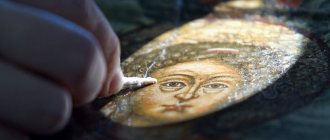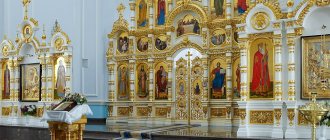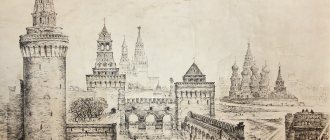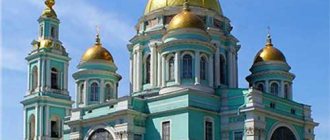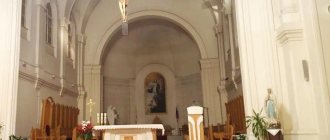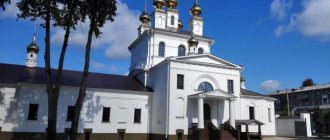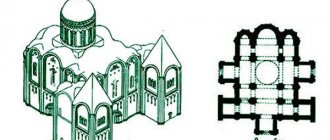“Like a single stone” - this is how the Assumption Cathedral of the Moscow Kremlin, currently the oldest building in the Russian capital, has long been characterized in chronicles. Beginning its history in 1326, the temple survived many fires, looting by Napoleon's troops, artillery fire from the Red Guards and even an earthquake, but still managed to withstand the storm of historical events. And the monolithic architecture of the temple by the Italian architect Aristotle Fioravanti acquired symbolic meaning, turning into a metaphor for the resilience of the Russian people and the Orthodox faith.
In addition to many revered icons, the Assumption Cathedral contains such relics as, for example, the Nail of the Lord and the staff of St. Peter, Metropolitan of Kyiv and All Rus', who initiated the construction of the cathedral. However, even a person far from religion will be extremely interested in visiting this temple.
Located on Cathedral Square, in the very heart of the Moscow Kremlin, the Assumption Cathedral is also firmly entrenched in the history of the country. Since 1498, coronations began to be held there. In 1613, Michael, the first ruler of the Romanov family, was crowned king here, and in 1896, the last Russian Emperor Nicholas II received the crown. In addition, for more than 3 centuries the cathedral was the resting place of the heads of the Russian Church. Without losing its cult significance, the Assumption Cathedral is an eloquent monument to how closely the secular and religious authorities in Rus' have always stood to each other.
All hotels near the Assumption Cathedral in Moscow
The history of the creation of the Assumption Cathedral of the Moscow Kremlin
The year of creation of the Assumption Cathedral of the Moscow Kremlin is considered to be 1472, when a solemn ceremony took place to mark the foundation and start of construction of the temple in the form in which it can be seen now. But the church stood in its place before, and the true history of the cathedral is actually longer by almost a century and a half.
The first foundation stone of the temple took place in 1326. Rus', fragmented into principalities, was then under the rule of the Horde. Moscow was ruled by Ivan Kalita, who, relying on the support of the Horde khans, won the confrontation with Tver, and then annexed a number of lands to his principality, purchasing them from the Golden Horde. The most successful step towards the rise of Moscow was the establishment of relations with the official religious authorities, and what a success!
Metropolitan Peter of Kiev and All Rus', who, like his predecessors, was in Vladimir, moved to Moscow in 1322, making it the official residence of the heads of the Russian Church, and 4 years later he initiated the construction of the first Assumption Cathedral. Thus, the creation of this temple initially became a political step that strengthened the independence of Moscow and strengthened the position of the principality.
© Maria Penina
The first building was made of roughly hewn white stone; it was single-domed and had only three apses. Later it was somewhat expanded beyond the limits. The main shrine was the Byzantine icon “Our Lady Hodegetria, with holidays in the fields.” The cathedral stood for a century and a half, but was severely damaged during a fire in 1470.
By this time, Rus' had already been liberated from the Tatar-Mongol yoke, the head of the church was called the Metropolitan of Moscow, not Kyiv, and Moscow itself was actively laying claim to the center of the state, around which the fragmented lands could unite. In this regard, they decided not to restore the Assumption Cathedral, but to overhaul it, making it more grandiose.
The project of the second Assumption Cathedral, which was carried out under the leadership of the Khovrin boyars, lasted for several years. However, it also went down in history, since a wooden church was built inside a huge construction site in 1472, in which Ivan III, who later became famous as the ruler who put an end to fragmentation, and Sophia Paleologus were married. Two years later, the almost completed temple was destroyed by an earthquake.
It became obvious that the new cathedral should not only have an impressive architectural appearance, but also a strong structure. This explained the choice of performer. By that time, Aristotle Fioravanti, a 60-year-old native of Bologna, had gained fame in Italy not only as a first-class architect, but also as an excellent engineer. Having started work on the Assumption Cathedral in 1474, he immediately introduced a number of innovations. Firstly, the white stone masonry was combined with brick, although there was no difference in appearance; secondly, the walls were reinforced with iron piles.
The years of creation of the Assumption Cathedral in the form in which it has survived to this day: 1472 - 1479. Who built it: Italian architect and engineer Aristotle Fioravanti.
The renewed Assumption Cathedral was consecrated in 1479, a couple of years later, icon painting and fresco master Dionysius, together with his students, painted its walls, and in 1498 the first coronation took place - Ivan III transferred the attributes of the wedding to the kingdom to his grandson Dmitry. In 1547, Ivan IV was crowned here.
Under Grozny, next to the southern gates of the cathedral, the “Royal Place” appeared - a luxurious carved tent 6.5 meters high, in which the head of state participated in church services separately from other parishioners. Also called the “Monomakh Throne” because of the bas-relief placed on the base and depicting scenes from “Tales of the Princes of Vladimir”.
©
In the 17th century, the era of the reign of the Romanovs began. Its first representative, Tsar Mikhail Fedorovich, elected by the Zemsky Assembly in 1913, received as a gift from the ruler of Persia Abbas I a precious relic - a fragment of the Lord's robe. Also, under the first Romanovs, the building itself was renovated: major repairs were carried out after fires, the vaults were strengthened with reinforcement.
In the middle of the 17th century, the walls of the temple were painted again - in 10 months, the artists created about 250 subject compositions, drawing more than 2 thousand figures! All of them form the main iconostasis: 69 icons are placed in 5 rows, and the total height of the composition reaches 16 meters.
The next, 18th century in the history of the Assumption Cathedral was marked by a great fire in 1737, which, according to contemporaries, destroyed a quarter of Moscow. The restoration of the Assumption Cathedral, like other churches in the Kremlin and the surrounding area, including St. Basil's Cathedral, was led by the architect Ivan Michurin. Due to the scale of the damage, restoration of the paintings inside the Assumption Cathedral was completed only 30 years later.
By the turn of the century, the iconostases of the southern and northern walls were replenished with icons from the Armory Chamber. For them, frames were made of gold and silver. However, parishioners and clergy did not admire them for long: in 1812, Napoleon’s soldiers who occupied Moscow melted down the jewelry into tons of precious metal ingots, and at the same time, during the retreat, they carried away all possible valuables, including a fragment of the Lord’s tunic.
In 1813, the Assumption Cathedral was re-consecrated, and the next century turned out to be extremely peaceful for it. In 1896, before the coronation of Nicholas II, a major renovation was carried out, during which the 16th-century paintings were exposed. In the 1910s, it was decided to completely release the ancient masterpieces. Restorers updated the images, adding missing fragments, gilding the backgrounds and strengthening the paint with drying oil. Thanks to these works, the paintings can still be seen today.
The last service in the Assumption Cathedral took place in April 1918, but the restoration of the frescoes was continued, including after the Great Patriotic War. Since 1955, the church has functioned as a museum. The Assumption Cathedral remains in this status today, being part of the Moscow Kremlin museum-reserve. But with the blessing of the patriarch, divine services are sometimes held here.
© Maria Penina
Who built
The first builders of the main temple of Moscow were Russian masters Krivtsov and Myshkin. However, they failed to complete the matter. Due to tremors, the walls of the church collapsed. It is believed that the cause was too weak a fastening. Tsar Ivan III decided to turn to recognized foreign architects for help. On his instructions, the embassy of Semyon Tolbuzin invited the hereditary Italian architect Ridolfo Fioravanti to Moscow. He was involved in the creation of religious buildings throughout Italy, and also worked in Hungary.
Before starting work on the church, the architect ordered the construction of a brick factory in the Moscow region. Thanks to the new building materials, the walls have become noticeably stronger. After the completion of the Assumption Cathedral, the architect remained in Russia and worked on fortification. According to legend, he was entrusted with the arrangement of a storage facility for the legendary liberium (library) of Ivan the Terrible.
Icons
The main iconostasis is located opposite the western gate. The ensemble, consisting of 69 icons, was created in 1653 by several artists from Kostroma and Yaroslavl in just 10 months. Structured in 5 rows. The upper, forefathers' row includes not only a full-length image of the forefathers with scrolls, but also an icon of the Holy Trinity. The prophetic level consists of 17 images. The festive row is filled with icons depicting the main events of the New Testament. The Deesis series includes images of the apostles, an icon with the prayer of the saints at the Last Judgment, and an icon of the “Savior Almighty.” In the bottom row are “The Golden Robe of Savior” and “The Ardent Eye of Savior.”
The most ancient icons are located near the southern wall, including “Metropolitan Peter with his Life.” It is believed that it was written by Dionysius, a follower of Andrei Rublev. The iconostasis near the northern wall contains icons by the servants of the Solovetsky Monastery. They were brought in 1923. The most famous images are “It is Worthy to Eat” and “The Mother of God of Bogolyubsk, with the Lives of Zosima and Savvaty of Solovetsky.”
Information for visitors
Entry to the museum complex is by ticket only. The ticket allows you to see the sights of Cathedral Square. This includes 3 cathedrals (including the Assumption), 2 churches and the Patriarchal Chambers.
Tickets
Tickets are sold in the Alexander Garden, at the entrance to the museum or on its website.
Ticket price:
| Total cost, rub. | Reduced price, rub. | |||
| 700 | 1000 | 500 | 800 (with audio guide) | Pass for free |
| Self review | Visit with audio guide |
|
| |
Visiting rules
Not allowed:
- photo and video shooting;
- passage with animals;
- visiting with bulky items (bags, various means of transportation, etc.).
Note. Strollers are allowed.
Working hours
The Kremlin Museum is open:
- from 9 a.m. to 5 p.m. (from mid-May to October 1);
- from 9:30 a.m. until 16:30 (during the rest of the year).
Thursday is a day off.
Contacts
To clarify the necessary information, please call:
- +79;
- +76;
- +77;
- +7.
Frescoes
The most ancient frescoes not only of the Kremlin, but of all of Moscow can be found on the altar barrier of the Assumption Cathedral. Dionysius and his team painted these images in the first years of the existence of the temple built by Fiorovanti. The main characters of the frescoes are ascetic monks who received the status of venerables. What saved the images from fading and destruction was the fact that they were hidden by the iconostasis for a long time, and they were discovered only towards the end of the 19th century.
© Julia Alisova
The frescoes in the central part of the cathedral were created in the mid-17th century. They are divided into cycles: “The Earthly Life of the Mother of God”, “The Earthly Life of Christ”, “Ecumenical Councils”, “Akathist”, “The Last Judgment”. The domes, pillars and vaults are also painted. The five domes of the cathedral serve as 5 canvases for various images of God. The pillars depict 135 martyrs, who are revered as the “pillars of the church.”
Service Schedule
Regular services have been held in the cathedral since 1992. They are held on the days of remembrance of the saints resting in the cathedral, and on major church holidays (the Dormition of the Virgin Mary, Christmas and Easter). However, you can only get into the service with a special invitation received from the Moscow Patriarchate.
In addition, on the day of Cyril and Methodius, a religious procession is held annually. On normal days, the Assumption Cathedral is open to the public at the same time as other Kremlin attractions.
Architecture
The appearance of the Assumption Cathedral is surprising in its difference from the cross-domed model traditional for Russian and Byzantine churches. In the usual version, one could observe a combination of parts of the building of different volumes. The façade of the Assumption Cathedral consists of spindles of identical width and height, ending with arched arcs, which gives rise to a feeling of solidity.
At the level of the windows of the lower tier there is a “belt” of the building - an architectural columnar frieze. Unlike other churches, it is not so voluminous and expressive and perfectly complements the restrained style of the cathedral.
There is an asymmetry in the composition, which is easy to see if you look at the temple from the southern facade. The heads of the cathedral, as well as the southern and northern gates, are shifted towards the east. At the same time, the apses located on the eastern side are not as voluminous as in the Byzantine tradition, and are covered with pylons. All together enhances the impression of massiveness, solidity, and unity.
© Maria Penina
How to get to the Kremlin Diamond Fund
We enter through the Borovitsky Gate. We arrive along the Armory building. There is always a guard there, we ask him if it is possible to get into the Diamond Fund. He will tell you what time the next session is.
We walk along this Armory building to the end
There is a security guard inside, from him you can find out information about the upcoming session at the Diamond Fund and about tickets
We did not get into the Diamond Fund. We were near the entrance at 13:30, asked the security guard how to get to the Diamond Fund, he replied that at 14:00 they would start selling tickets for 16:00. We visited the Armory Chamber, left it at about 16:00, again approached the entrance to the Diamond Fund, but there were no tickets for today.
Cathedral Square
In the center of the Kremlin ensemble is Cathedral Square. Since ancient times, all the central streets of the famous fortress city converged on it. This square hosted solemn celebrations of the Russian capital - meetings of foreign ambassadors, Orthodox services, processions during the wedding and coronation of kings.
The majestic and harmonious ensemble of Cathedral Square was created by the talent and labor of Russian architects, as well as Italian craftsmen. Its current appearance was formed at the end of the 15th century. The Arkhangelsk and Annunciation Cathedrals, the Assumption Cathedral of the Moscow Kremlin, as well as other churches and temples located on this territory are the greatest monuments of original Russian architecture and history. They gave the square its name. Since ancient times, it has been the cradle of Russian culture and a symbol of the mighty Russian empire.
Current status
Opened as a museum in 1955.
In February 1960 it was transferred to the jurisdiction of the USSR Ministry of Culture.
Since 1991, it has been part of the State Historical and Cultural Museum-Reserve "Moscow Kremlin".
Since 1990, divine services have been held on separate days with the blessing of the Patriarch; is called the “Patriarchal Cathedral”.
Shrines
The Nail of the Lord and the staff of St. Peter, Metropolitan of Kyiv and All Russia, are preserved in the cathedral.
The cathedral was the burial place of most Moscow saints before the establishment of the Holy Synod.
Here rest the relics of: Metropolitans of Kyiv Peter, Theognostus, Photius, Cyprian and Jonah; Metropolitans of Moscow Macarius and Philip; Patriarchs of Moscow Job and Hermogenes.
Since 1395, the Vladimir Icon of the Mother of God has been in the cathedral (since 1930 in the Tretyakov Gallery, in the St. Nicholas Church in Tolmachi).
Iconostasis
The iconostasis of the cathedral was created in 1653 on the initiative of Patriarch Nikon. Its sixty-nine icons illustrate the entire biblical history of mankind. The top row is the forefathers - the Old Testament period preceding the incarnation of Christ. In the next prophetic row, the prophets are depicted in front of Our Lady of the Sign; they hold scrolls with the texts of prophecies about Christ. In the festive row there are icons dedicated to the main events of the life of Christ. The main one is the Deisis rite, reminiscent of the Second Coming: the Mother of God, John the Baptist and, in accordance with Greek tradition, the twelve apostles stand before Christ the Pantocrator in prayerful poses.
Tomb
Since 1326, when Metropolitan Peter was buried in the unfinished church, the cathedral served as the tomb of Russian high priests.
There are 19 tombs in the cathedral. From the end of the 16th century, brick tombstones with white stone epitaphs began to be installed over the tombs, and at the beginning of the 20th century, the tombstones were enclosed in metal covers. The burial places of holy priests are highlighted by high tents - vestibules.
The relics of the Moscow wonderworkers Peter (+ 1326), Jonah (+ 1461), Philip (+ 1569) and Hermogenes (+ 1612) rest in wooden reliquaries decorated with metal plates.
The following were buried in the cathedral tomb:
Metropolitans of Moscow
- Theognostus (+ 1353)
- Cyprian (+ 1406)
- Photius (+ 1431)
- Philip I (+ 1473)
- Gerontius (+ 1489)
- Simon (+ 1511)
- Macarius (+ 1563)
Patriarchs of Moscow
- Job (+ 1607)
- Filaret (+ 1633)
- Joasaph I (+ 1640)
- Joseph (+ 1652)
- Joasaph II (+ 1672)
- Pitirim (+ 1673)
- Joachim (+ 1690)
- Adrian (+ 1700)
Royal prayer place
The royal place of prayer - the Monomakh Throne - was created in 1551 for the first Russian Tsar Ivan the Terrible. Its performers were probably Novgorod carvers. Here are presented various motifs and techniques of carving that were once widespread in Rus'. At the base there are four round sculptures - images of fantastic predatory animals. They carry a square structure with a complex shape of columns, balusters, valances, topped with an intricate tent with numerous kokoshniks, rosettes and vases. Twelve bas-reliefs on the walls illustrate “The Tale of the Princes of Vladimir,” which tells about the bringing of royal regalia to Rus' - the Monomakh cap, barm (ceremonial mantle) and other items.
Abbots
- Vasily Platonov (March 16, 1840 - April 11, 1856)
- Dimitry Novsky (1874 - 1878)
- Mikhail Bogoslovsky (1879 - January 9, 1884)
- Nikolai Sergievsky (1884 - 1892)
- Nikolai Blagorazumov (July 16, 1892 - ?)
- Nikolai Svetovidov-Platonov (? - 1897)
- Alexander Ilyinsky (1897 - 1899)
- Vladimir Markov (January 1900 - August 11, 1911)
- Nikolai Lyubimov (August 12, 1911 - 1918)
